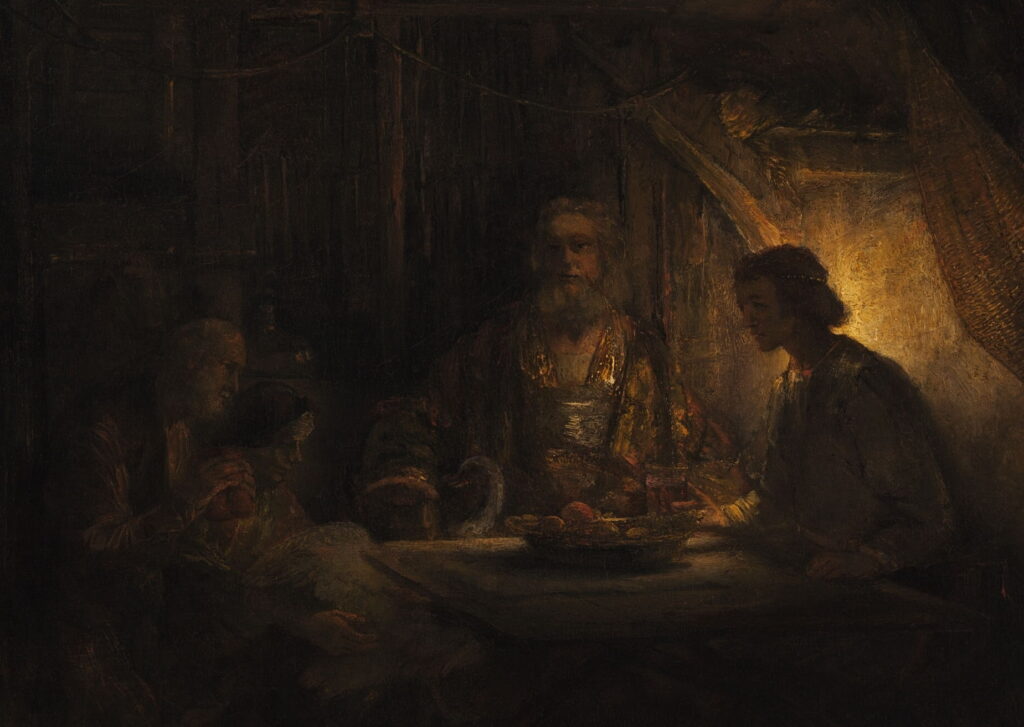Reading visual art: 156 Hospitality in myth

In the past, hospitality to strangers was high on the list of virtues expected of everyone, however rich or poor they might have been. To ensure that those living in the ancient world respected the code of hospitality, there were several myths to help guide the mind. Today I look at how paintings of those myths have communicated the need to be hospitable, and tomorrow’s sequel will look at more recent religious and moral teaching.
The first myth is brief, part of the saga of Perseus and Andromeda, but memorable.
Edward Burne-Jones (1833–1898), The Perseus Series: Atlas Turned to Stone (1878), bodycolour, 152.5 × 190 cm, Southampton City Art Gallery, Southampton, England. Wikimedia Commons.
After Perseus has beheaded the gorgon Medusa, he flies over the desert sands of Libya, the blood still dripping from Medusa’s head and falling onto the sand to form snakes. With dusk approaching, he decides to set down in the lands of the giant Atlas. He introduces himself to Atlas, including explanation of his divine paternity, and asks for rest and lodging for the night.
The giant, mindful of a prophecy that a son of Jupiter will ruin him, rudely refuses his request, and starts to wrestle with his spurned guest. Perseus responds by offering him a gift, then, taking care to avert his own face, points Medusa’s face at Atlas, who is promptly transformed into a mountain.
In Edward Burne-Jones’ Atlas Turned to Stone (1878) the giant has been turned to stone and now stands bearing the cosmos on his shoulders as Perseus flies off to Aethiopia.
The definitive classical myth stressing the importance of showing hospitality is the story of Philemon (husband) and Baucis (wife), as told in Ovid’s Metamorphoses Book 8. This pious elderly couple live in a town in Phrygia, now west central Anatolia, in Turkey. One day, two ordinary peasants walked into the town, looking for somewhere to stay for the night. Everyone else rejected them, but when they asked this couple, who were among the poorest inhabitants and had but a simple rustic cottage, they were welcomed in. Philemon and Baucis served their guests food and wine, and when they realised they were entertaining gods, the couple raised their hands in supplication and craved indulgence for their humble cottage and fare.
Revealing themselves as the gods Jupiter/Zeus and Mercury/Hermes, the guests told them to leave town, as it was about to be destroyed, together with all those who hadn’t offered them hospitality. The gods then took the couple out to climb a mountain, telling them not to look back until they had reached the top. Once at the summit, they turned to see the town obliterated by a flood; their cottage had been spared, turned into a temple, and Philemon and Baucis were made its guardians.
Adam Elsheimer (1578–1610), Jupiter and Mercury with Philemon and Baucis (1609-10), oil on copper, 16.5 x 22.5 cm, Gemäldegalerie Alte Meister, Dresden. Wikimedia Commons.
Adam Elsheimer, in his small oil on copper painting Jupiter and Mercury with Philemon and Baucis (1609-10), shows Philemon (right) and Baucis (centre right) giving their hospitality generously to Jupiter (left) and Mercury (centre left), in their tiny, dark cottage. All four are depicted in more contemporary dress, although Mercury’s winged helmet is an unmistakeable clue as to his identity. Their modest stock of food is piled in a basket in the right foreground, and a goose is just distinguishable in the gloom at the lower edge of the painting, below Mercury’s feet.
David Rijckaert (III) (1612–1661), Philemon and Baucis Giving Hospitality to Jupiter and Mercury (date not known), oil on panel, 54 x 80 cm, Private collection. Wikimedia Commons.
David Rijckaert, in his Philemon and Baucis Giving Hospitality to Jupiter and Mercury, gives what has become the most popular depiction: Mercury (left) and Jupiter (left of centre) seated at the table, with Philemon (behind table) and Baucis (centre) waiting on their every need, ensuring that they eat and drink their fill. Baucis has almost caught their evasive goose, and an additional person is shown in the background preparing and serving food for the gods.
Rembrandt Harmenszoon van Rijn (1606–1669), Baucis and Philemon (1658), oil on panel mounted on panel, 54.5 × 68.5 cm, The National Gallery of Art, Washington, DC. Courtesy of The National Gallery of Art, via Wikimedia Commons.
Rembrandt’s Baucis and Philemon (1658) shows Jupiter (looking decidedly Christlike) and Mercury (the younger, almost juvenile, figure) sat at the table of a very dark and rough cottage, lit by a lamp behind Mercury.
Rembrandt Harmenszoon van Rijn (1606–1669), Baucis and Philemon (detail) (1658), oil on panel mounted on panel, 54.5 × 68.5 cm, The National Gallery of Art, Washington, DC. Courtesy of The National Gallery of Art, via Wikimedia Commons.
Philemon and Baucis are crouched, chasing their evasive goose towards Jupiter. A humble bowl of food is in the centre of the table, and there is a glass of what appears to be beer. As is usual in Rembrandt’s narrative paintings, he dresses them in contemporary rather than historic costume.
The moral here doesn’t need to be spelled out any further: fail in your duty to offer hospitality to strangers and the gods may end your life. Another myth told by Ovid in his Metamorphoses isn’t quite as damning. Instead of death, you could be turned into a frog instead. So says Ovid’s account of the Lycians who shunned the goddess Leto when all she needed was a drink of water.
Fearing reprisals from the jealous Hera (Juno), when Leto (Latona) is about to give birth to her twins, she flees to Lycia, at the western end of the south coast of modern Turkey. This was a centre for Leto’s worship, but at some stage the goddess must have become scorned by those living in the country there.
When the twins, Diana and Apollo, had drunk Leto’s milk and she was dry and thirsty under the hot sun, she saw a small lake among marshes, where local peasants were cutting reeds. She went down and was about to drink from the lake when those locals stopped her. Leto told them that drinking the water was a common right, and that she only intended to drink and not to bathe in it.
The locals continued to prevent her, threatening her and hurling insults. They then stirred up the mud on the bottom of the lake, to muddy the water, incurring the goddess’s anger and causing her to curse them to remain in that pool forever as frogs. It’s this transformation that forms the basis for the many paintings of this myth.
Annibale Carracci (1560–1609), Latona and the Lycian Peasants (date not known), oil on canvas, 90.6 x 78 cm, Arcidiecézní muzeum Kroměříž, Olomouc Museum of Art, Kroměříž, The Czech Republic. Wikimedia Commons.
Annibale Carracci’s Latona and the Lycian Peasants probably from 1590-1620 is the first truly masterly painting of this myth. Latona is here placing her curse on the locals, and behind them one appears to have already been transformed into a frog. Although the babies’ heads are disproportionately small (as was the case for several centuries), they and their mother are very realistically portrayed, and contrast markedly with the uncouth and obdurate locals.
Jan Brueghel the Elder (1568–1625), Latona and the Lycian Peasants (1595-1610), oil on panel, 37 × 56 cm, Rijksmuseum Amsterdam, Amsterdam, The Netherlands. Wikimedia Commons.
Jan Brueghel the Elder’s panel showing Latona and the Lycian Peasants (1595-1610) is one of the finest depictions. Set in a dense forest, surely inappropriate for Lycia, the locals are busy cutting reeds and foraging. Leto, at the bottom left, is seen remonstrating with a peasant, over to the right. As the detail below shows, the goddess is in need, as are her babies. The peasant closest to her, brandishing his fist, is already rapidly turning into a frog. There are many other frogs around, including a pair at the bottom left corner, near the feet of one of the babies.
Jan Brueghel the Elder (1568–1625), Latona and the Lycian Peasants (detail) (1595-1610), oil on panel, 37 × 56 cm, Rijksmuseum Amsterdam, Amsterdam, The Netherlands. Wikimedia Commons.
David Teniers the Younger (1610–1690), Latona and the Frogs (c 1640–50), oil on copper, 24.8 × 38.1 cm, Fine Arts Museums of San Francisco, San Francisco, CA. Wikimedia Commons.
David Teniers the Younger’s Latona and the Frogs from around 1640–50 isn’t in the same class as Brueghel’s, but still tells the story well, and shows Lycians being transformed for refusing to help the goddess.
François Lemoyne (1688–1737), Latona and the Peasants of Lycia (1721), oil on canvas, 77.5 × 97.8 cm, Portland Art Museum, Portland, OR. Wikimedia Commons.
François Lemoyne’s Latona and the Peasants of Lycia (1721) stops short of showing the metamorphosis or resulting frogs, but Latona and the peasants are clearly engaged in their dispute.
Gabriel Guay (1848–1923), Latona and the Peasants (1877), oil, dimensions not known, Château du Roi René, Peyrolles, Provence, France. Wikimedia Commons.
The story survived in narrative painting well into the latter half of the nineteenth century, when Gabriel Guay, an eminent former pupil of Jean-Léon Gérôme, painted his Latona and the Peasants (1877). Leto and her babies now seem not just real but almost contemporary, minimising her divinity.



